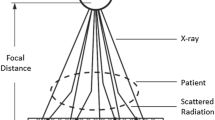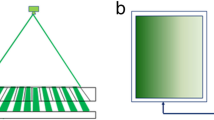Computed radiography (CR) has many advantages such as filmless operations, efficiency, and convenience. Furthermore, it is easier to integrate with the picture archiving and communication systems. Another important advantage is that CR images generally have a wider dynamic range than conventional screen film. Unfortunately, grid artifacts and moiré pattern artifacts may be present in CR images. These artifacts become a more serious problem when viewing CR images on a computer monitor when a clinic grade monitor is not available. Images produced using a grid with higher frequency or a Potter–Bucky grid (i.e., a moving grid, Bucky for short) can reduce occurrence but cannot guarantee elimination of these artifacts [CR & PACS (2000); Detrick F (2001), pp 7–8]. In this paper, the formation of the artifacts is studied. We show that the grid artifacts occur in a narrow band of frequency in the frequency domain. The frequency can be determined, accurately located, and thus removed from the frequency domain. When comparing the results obtained from the proposed method against the results obtained using previous computer methods, we show that our method can achieve better image quality.








Similar content being viewed by others
References
Cesar LJ, Schueler BA, Zink FE, Daly TR, Taubel JP, Jorgenson LL: Artifacts found in computed radiography. Br J Radiol 195-202, 2001
Lee Wen-jeng, Tsao Bo-Shen, Ching Yu-Tai, Chen Shyh-Jye, Chang Chia-Hung, Chen Chien-Jung, Yen York, Lee Yuan-Ten: High Resolution Hand-held computer as a Portable PACS Terminal Using Wireless LAN and GPRS. EuroPACS 2002 Conference, Oulu, Finland
Wang Jun, Huang HK: Film digitization aliasing artifacts caused by grid line patterns. IEEE Trans Med Imaging 375–385, 1994
Barski LL, Wang X: Characterization, detection and suppression of stationary grids in digital projection radiography imagery. Proc SPIE 502-519, 1999
Belykh IN, Cornelius CW: Antiscatter stationary grid artifacts automated detection and removal in projection radiography images. Proc SPIE 1162–1166, 2001
Sasada R, Yamada M, Hara S, Takeo H: Stationary grid pattern removal using 2-dimensional technique for Moire-free radiographic image display. Proc SPIE, 2003
Castlenman KR: Digital Image Process. Upper Saddle River, NJ: Prentice Hall International Editions, p. 41, 1996
J Beutel HL Kundel RLV Metter (Eds) (2000) Handbook of Medical Imaging: Physics and Psychophysics SPIE Press Bellingham, WA
JT Bushberg (2002) The essential physics of medical imaging EditionNumber2nd ed. Lippincott Williams & Wilkins Baltimore, MD
Rowlands JA: The physics of computed radiography. Phys Med Biol 123-166, 2002
Ganten M, Radeleff B, Kampschulte A, Daniels MD, Kauffmann GW, Hansmann J: Comparing image quality of flat-panel chest radiography with storage phosphor radiography and film-screen radiography. Am Roentgen Ray Soc 171-176, 2003
Chaefer-Prokop C, Uffmann M, Eisenhuber E, Prokop M: Digital radiography of the chest: detector performance parameters. J Thorac Imaging 124-137, 2003
Harrell G, Chotas T. James, Dobbins E. Carl, Ravin: Principles of digital radiography with large-area, electronically readable detectors: a review of the basics. Rev Princ Digit Radiogr 595-599, 1999
JA Cadzow HF Landingham ParticleVan (1974) Signals, Systems, and Transform Prentice-Hall Englewood Cliffs, New York
Linden DA: A discussion of sampling theorems. Proc. IRE 1219-1226, 1959
JW Goodman (1968) Introduction to Fourier Optics McGraw-Hill New York
O Kafri I Glatt (1990) Topography and Spinal Deformity Wiley New York
Lia M, Wilsona D, Wonga M, Xthona A: The evolution of display technologies in PACS applications. Comput Med Imaging Graph 175-184, 2003
CR & PACS: Insights & Images—Grids for Computed Radiography. The User’s Publication of Computed Radiography, Fall 2000
Detrick F: PACS Planning Guide. Air Force Medical Logistics Office/FOE, Technology Integration and Support Team, pp 7-8, 2001
DICOM Standard: Digital Imaging and Communications in Medicine (DICOM) Part 3: Information Object Definitions. National Electrical Manufacturers Association, 2004
Fujifilm Standard: DICOM Conformance Statement Fuji Computed Radiography QA-WS771. Fuji Photo Film Co. Ltd, Japan, 2001
AGFA: Healthcare DICOM Conformance Statement: ADC-QS Version 2.1. HealthCare Glasgow Business Community, Sep., 2002
Bushong SC: Physics, Biology, and Protection. Radiologic Science for Technologists,” 7th ed. 2001
Acknowledgments
This work was supported under the grants NSC-90-2213-E-009-119, National Science Council, Taiwan, and 91-S009 from the National Taiwan University Hospital, Taipei, Taiwan.
Author information
Authors and Affiliations
Corresponding author
Rights and permissions
About this article
Cite this article
Lin, CY., Lee, WJ., Chen, SJ. et al. A Study of Grid Artifacts Formation and Elimination in Computed Radiographic Images. J Digit Imaging 19, 351–361 (2006). https://doi.org/10.1007/s10278-006-0630-8
Published:
Issue Date:
DOI: https://doi.org/10.1007/s10278-006-0630-8




